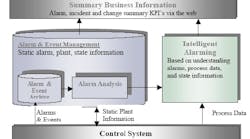Alarm systems are implemented with an objective of running the plant safely and increasing the plant uptime. Poor management of alarms renders the entire alarm system ineffective and makes it difficult to achieve the above objective. Until now, long term archiving of alarms and events is the only improvement to existing control system capabilities, and is now becoming a commodity.
This approach, does not address the real problem companies face: "How do I manage my alarm system?" The alarm management solution must directly target the real issues. The solution must take into account the key elements of the total alarm management problem, including:
The alarm management solution must directly target the real issues. The solution must take into account the key elements of the total alarm management problem, including:
- Alarm archiving
- Alarm analysis
- Alarm enforcement
- Establishing a consistent alarm philosophy
- Managing the reasons for, and the history of alarm settings
- Correlating alarms to plant equipment and state information
- Intelligent alarming based on alarm relationships to plant and equipment state and process data
Alarm Analysis
Although this should be a commodity, very few companies offer quality alarm analysis. Some, on the other hand, have done extensive work in this area, and offersstandardized guided alarm analysis. The guide provides a systematic way of identifying common problems related to alarms (such as standing alarms, chattering alarms, stale alarms, SOEs).
Alarm Management
Solution and product providers have not recognized this as being the key issue that many companies face. Alarm management starts by addressing the basic issues with an alarm system. It is essential to establish the need for an alarm and clearly identify the operator action required for the alarm and the consequences of missing the alarms. Historically, the above exercise was done in conjuction with HAZOPs or other adhoc procedures and was a manual process. The problems with such an approach are numerous, including:
- Many man days of effort
- Little to no automation
- Procedures re-learned in every plant
- History and knowledge of alarm changes lost, or difficult to access
- Lack of a consistent alarm philosophy
- Lack of, or non existent, integration of other key information, such as HAZOP and incident documents
The reality is that a vast wealth of knowledge and information is not being utilized, and more importantly, the base process that each plant undertakes to do alarm reviews is the same, but not being leveraged very well. The above information must be captured in a central alarm management database to guide alarm management and analysis by providing a consistent structure and path.
- Standardized Alarm Philosophy Document
- Purpose and objectives of alarm system
- Alarm priorities
- Conventions
- Priority assignments
- Rules for prioritizing alarms
- Management of change
- Alarm management system
- Alarm change tracking and management of change
- Standardized procedures/recommendations for changing alarms
- Consistent procedures for selecting alarm priorities and limits
- Integration with HAZOP studies and Six Sigma strategies
- Basic incident tracking and capability to link to incident systems
- Performance metrics
- Alarm metrics
- Incidents
- Relations of alarm metrics to incidents
- Compare individual alarm metrics/incident entries
- Plant asset hierarchy database
- Plant state information (startup or shutdown of an equipment, repairing instruments, running at lower than normal rates, etc)
The net result is man months of saved review time, continued management of the alarm system, and better operations resulting in improved production and safer operating conditions.
Alarm Enforcement
Tools are also necessary to support management of change of the alarm database. It is necessary to compare the current state of the alarm system with the "benchmarked" state of the system to ensure that critical alarm limits have not been modified in any way.
Relationship of Alarms to Plant Equipment and State
To easily make use of an alarm management product it is necessary to relate alarms to the physical plant assets, as well as, plant state information. By identifying these relationships, data mining is based on the physiology of the plant and is thus more intuitive. More importantly, the state of the plant operations has a tremendous impact on the alarm system, and is often the key problem that operators face. Nuisance alarms are generated due to the inability of the control system to dynamically change alarm limits as the plant changes. By identifying valid alarm states, the alarms the operators must deal with are substantially reduced during abnormal situations, and can help ensure smooth and safe operations.
Intelligent Alarming
Intelligent alarming has been the long sought "treasure". In the efforts to achieve this goal, if the goal were ever achieved, alarm relationships and static information has been re-engineered on a per solution basis, but no means of re-using these foundations has been well established.
One of the key reasons for this failure is that the management of this information has been neglected. With standardized management products and analysis techniques in place, the ability to provide intelligent alarm information is possible.
As changes occur in state, the plant, or more importantly, to the alarm system, with an easy to use management tool, the effectiveness of intelligent alarming applications is more realistic on a sustained basis.




